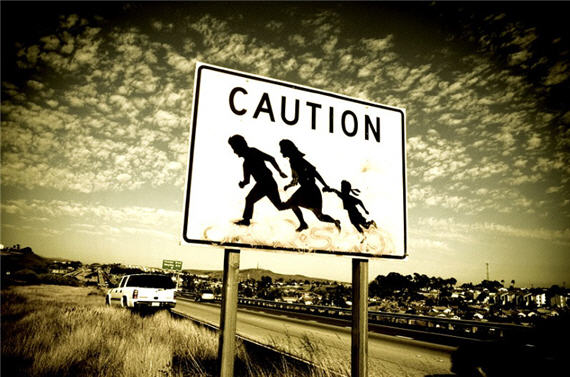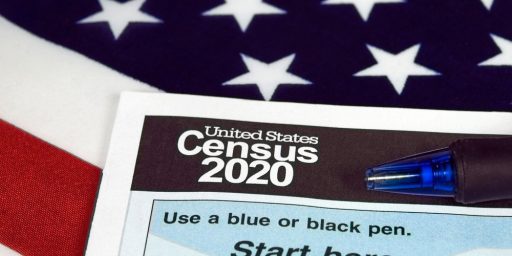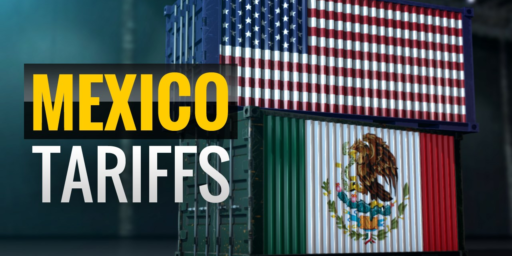More Immigrants To The U.S. Come From China And India Than Mexico
The sources of new immigrants to the United States are changing, but it's unclear if that will have any impact on the political debate over immigration reform.
According to a new study, India and China have surpassed Mexico as the primary sources of immigration to the United States:
Move over, Mexico. When it comes to sending immigrants to the U.S., China and India have taken over, research being presented Friday at the Population Association of America conference shows.
China was the country of origin for 147,000 recent U.S. immigrants in 2013, while Mexico sent just 125,000, according to a Census Bureau study by researcher Eric Jensen and others that analyzed annual immigration data for 2000 to 2013 from the American Community Survey. (An “immigrant” here is any foreign-born person in the U.S. who lived abroad a year prior, regardless of legal status, though undocumented immigrants may be undercounted in the survey.) India, with 129,000 immigrants, also beat Mexico, though the two countries’ results weren’t statistically different from each other.
A year earlier, in 2012, Mexico and China had been basically tied for top-sending country—with Mexico at 125,000 and China at 124,000.
It’s not just China and India. Several of the top immigrant-sending countries in 2013 were from Asia, including South Korea, the Philippines and Japan.
For a decade, immigration to the U.S. from China and India, which boast the world’s biggest populations, has been rising. Meanwhile, immigration from Mexico has been declining due to improvements in the Mexican economy and lower Mexican birth rates. More recently, the Great Recession also reduced illegal immigration from Mexico.
A shift in America’s immigrant community will take far longer. In 2012, five times as many immigrants in the U.S. were from Mexico than China.
But the shifting nature of the immigrant flows seen in the Census study give us a peek at what’s likely to happen to the overall racial and ethnic makeup of the U.S. population.
The millennial generation—roughly speaking, people born between 1982 and 2000, but definitions vary and there’s no real endpoint—is already the most diverse generation in U.S. history. As Brookings Institution demographer William Frey details in his recent book, “Diversity Explosion,” the social, economic and cultural implications are just starting to come into view. In time—2044, to be exact, according to Census projections—the entire U.S. population will have no racial majority, and, instead, a melting pot of minorities will shape U.S. society and politics.
Hispanics are still America’s biggest racial or ethnic minority group. But roughly two-thirds of them are now native-born, not recent immigrants. Among the U.S. Asian population, two-thirds (65%) are foreign-born.
On some level, of course, this isn’t entirely surprising since we’e already seen signs that immigration from Mexico especially, and from other parts of Latin America was slowing down from the levels we had seen in recent decades. In 2011, for example, it was reported that immigration from Mexico was at its lowest level in 60 years, and subsequent reports indicated that there may have actually been reverse immigration in the later part of the last decade. To a large degree, of course, the drop-off in immigration from that part of the world was due to the Great Recession and, especially, the impact that it had on the construction industry. For a the better part of a decade prior to 2008, the boom in both residential and commercial construction in the United States provided lucrative opportunities for relatively unskilled workers in fields such as carpentry and other construction-related fields. In many parts of the country at the time, a trip through a housing or commercial development under construction would reveal large numbers of Hispanic laborers many of whom, no doubt, were in the country illegally and attracted by the steady work and good wages that these fields provided. Once the economy crashed, the economy was one of the hardest hit sectors and many of these laborers were among the hardest hit. Some of them found other work, some of them returned to their home countries, but in any case the message was sent that the opportunities in the United States were not quite as good as they had been. In addition to the changes in the U.S. economy, changes in Mexico have also contributed to changes in immigration. The Mexican economy has improved, for example, and the birth rate among Mexican families has fallen dramatically from what it used to be, meaning that there is less pressure for young adults to seek opportunity elsewhere.
The biggest difference between immigration from China and India and immigration from Mexico, of course, is that it is far less easy for Chinese or Indian citizens to enter the country illegally, thus meaning that a larger portion of those immigrant populations are likely to be legal immigrants. No doubt, at least some of the immigration from these nations, and elsewhere, consists of people who arrive here on visas and then overstay the visa, but that is a different kind of “illegal” immigration than the border crossing that has become such a hot-button issue among conservatives. Additionally, it’s likely that many of the immigrants from China and India that are being talked about here are far more skilled than immigrants from Mexico and the rest of Latin America. Whether that will change Republican opinions on immigration or not remains to be seen. Of course, Chinese or Indiana citizens wishing to come to the United States must deal with the byzantine and overly restrictive legal immigration system that we have in the United States. To the extent that these are people we want to encourage to come to the United States because of their skills, we are making it hard for them to do so. The immigration bill that died in the Senate at the end of last year would have liberalized the legal immigration to some degree, but of course there seem to be little hope that the GOP will even bother to pursue that issue before the 2016 elections. So, those Chinese and Indians who are getting here should probably be thankful they’ve been able to make it through the system.






HAHAHAHAHAHAHAHAHAHAHAHAHAHA…..
Not real familiar with hammer and saw, are you Doug?
Compared to other areas involved in construction such as plumbers and electricians, carpentry strikes me as falling in the ‘relatively unskilled’ category in that it doesn’t take very much training for someone to be able get to work.
@Doug Mataconis:
The unskilled workers don’t get hired as carpenters, they are hired as laborers. The laborers clean up the side, hold things in place, and will sometimes bang in nails or screw in screws. That they will hold up a piece of wood or bang in a nail does not make them carpenters. You have basically made the equivalent error to calling a legal secretary a lawyer.
Fine, I revised the sentence in question.
Now, how about some comments that are relevant to the subject of the post?
Well, to be fair, proper comments can only flow from an accurate post…
In the modern era, any debate on immigration numbers/regions is really about the tension between labor and capital.
In particular, the recent flow of immigrants from China and India is likely directly related to changes in our economy – particularly Tech. My US-based company outsources as much as possible to both India and China (both subsidiaries and vendor staffing) because labor rates are so much cheaper there. Projects generally go well, although we often need to have US employees clean things up a bit for US customers. I feel like a lot of that has to do with the cultural expectations of US customers vs. the expectations abroad. We may be a global economy, but we are not a global culture – and the work ethic varies broadly between countries.
As you might imagine, we have a constant stream of folks who want to come to the US, which puts a nice wage-ceiling on US-born STEM workers.
This is neither good nor bad. To the extent US workers remain somewhat competitive in the global market, those jobs are sustainable for the long-term. Feels like the right amount of tension between employer/employee at the moment. I’m sure there are wage pressures coming.
Huh. Interesting in that it confirmed a vague sense I’ve had lately. When I was living in Irvine a couple four years ago it was clear the city was turning Indian. And now here in Tiburon my neighbors on one side are Indian-American and on the other, Indian Indian. It felt like I was suddenly seeing a lot of Indians.
My own personal immigration policy is that we should welcome those who bring good food. Indians, Chinese and Mexicans all qualify. Canadians not so much – we’ve got plenty of beer and donuts – no offense to our brothers and sisters up on the tundra.
Doug, I think you’re radically underestimating the proportion of Chinese immigrants that are illegal and not highly skilled. Google snakehead and Fujianese.
@michael reynolds: “My own personal immigration policy is that we should welcome those who bring good food. Indians, Chinese and Mexicans all qualify. Canadians not so much – we’ve got plenty of beer and donuts – no offense to our brothers and sisters up on the tundra.”
You’re forgetting poutine, which (imo) is sufficient reason to keep the Canadians out.
@michael reynolds:
Immigration from India isn’t new to me, really. When I was growing up in Central NJ there was a huge amount of Indian immigrants that were moving into the area. The first wave seems to have been because of the nearby location of companies like Bell Labs and Hewlett Packard (which at the time had a fairly large corporate office in the town I grew up, not sure if it’s there anymore) as well as the fact that we were close to New York City and to universities with strong engineering programs like Rutgers and Princeton.
After that group moved in, the next wave followed and they ended up being the people who did things like open fast food franchises and operate gas stations and liquor stores.
There was quite a culture conflict when I was in High School but, now that I’ve had to go back a lot more often since my Dad passed it seems like there’s also been a lot assimilation.
The Asian population here has always been high, but it does seem like the Chinese population is increasing at a faster rate now. That could just be the effect of moving to a different island though.
You say things like that just to hurt the rest of us don’t you?
@Lynn: @michael reynolds: You are both forgetting about peameal bacon. I have never seen it for sale in the States, if we want some when we are camping in the US we need to bring it with us. The best breakfast meat ever cooked over the fire. I have seen “Canadian bacon” in the US but it is not remotely the same.
Seriously, one of the side effects of what seems to be more stringent enforcement of many existing rules is that Canadian seniors are also getting caught if they overstay the six months they are allowed to spend in Florida each winter. It was always kind of funny to hear them complain about immigrants when they were blatantly breaking immigration law every year.
@Pete S: Seriously, one of the side effects of what seems to be more stringent enforcement of many existing rules is that Canadian seniors are also getting caught if they overstay the six months they are allowed to spend in Florida each winter. It was always kind of funny to hear them complain about immigrants when they were blatantly breaking immigration law every year.”
Like the British expats in the south of Spain who said they left the UK because of all the damn immigrants who wouldn’t learn proper English.
They, of course, spoke no Spanish.
“You are both forgetting about peameal bacon.”
I’m a vegetarian … you can keep your bacon!
yet ironically whenever we read about “illegals” there’s usually a picture of someone ‘hispanic” looking. i blame the msm…..
Kinda like when Fox News whines about voter fraud and shows images of lines of black citizens at polling places.
Build the dang wall.
Oh…wait…
@Grewgills: I worked as a helper/laborer in the plumbing field. Pay was not bad. It was hot, heavy, dirty work. But my experience grew and that skill has been a valuable back up. I get any number of calls from friends and neighbors who are needing a leak fixed, or a fixture installed. People have to have potable water and water for washing so there will always be a need for plumbers. Electricians, painters, flooring people, roofers, welders, equipment operators, and others too. Likewise who wants to do.without ac or heat ? A hvac repairman is going to charge $80 just to get out of the truck. So the skilled trade fields are good areas.There are different areas of carpentry: framing, forms, finish cabinetry, and furniture. Brick masons are scarce. I knew a lawyer that left the practice to become a mason, said he wanted to work outdoors with his hands.